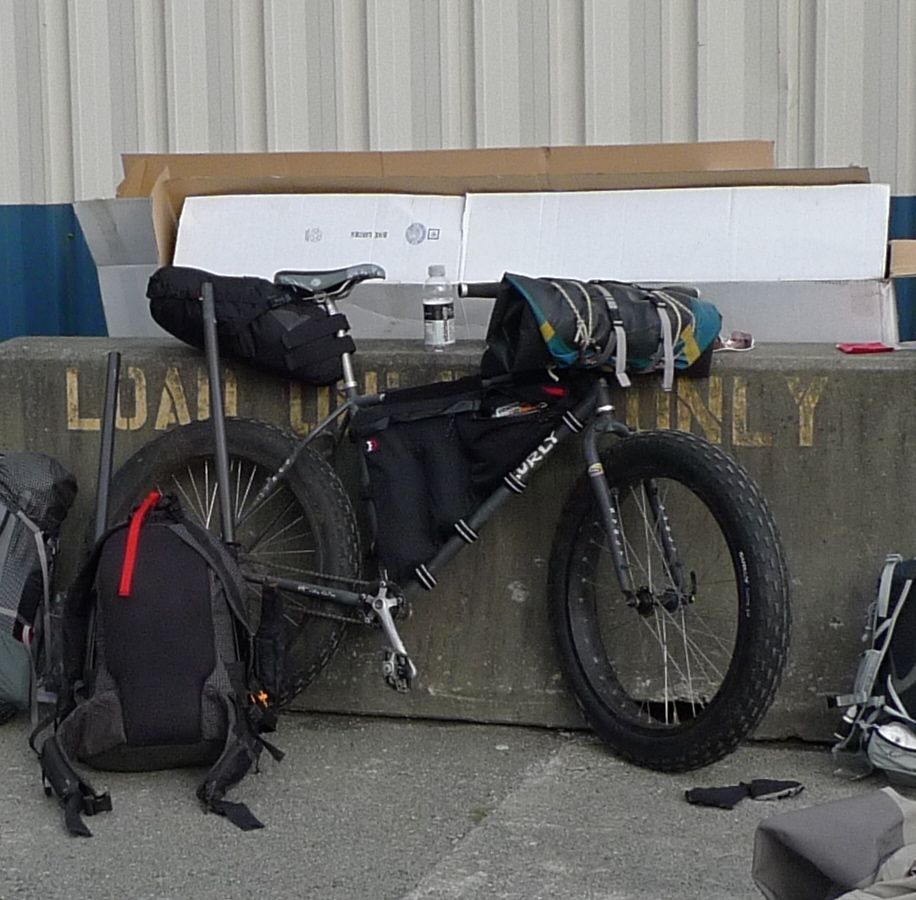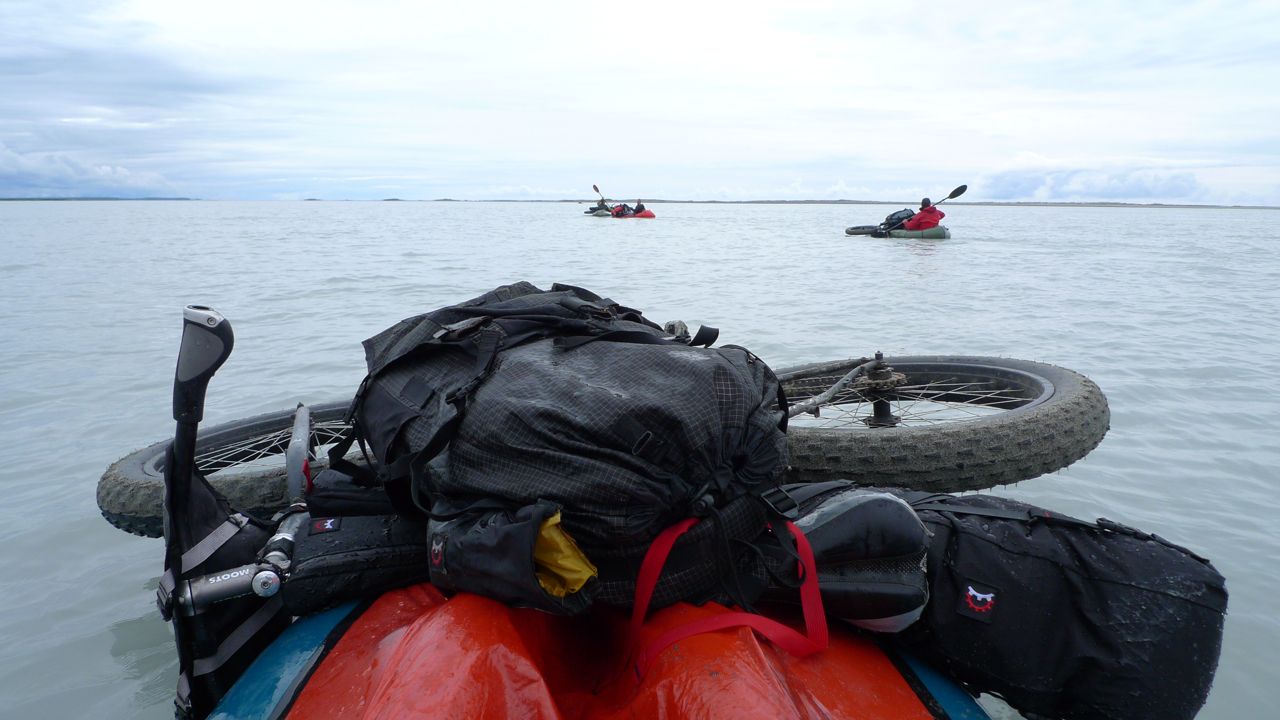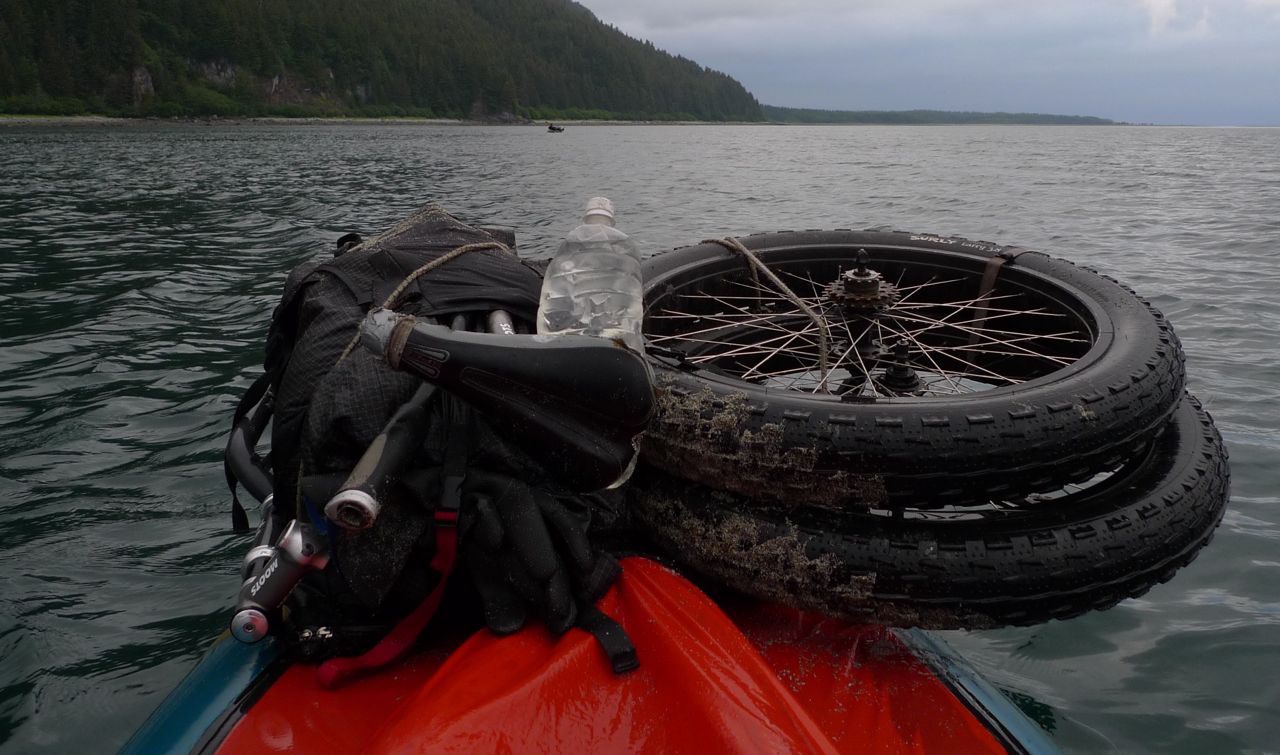I've had a bunch of questions about gear for the beach trip so here goes. A key point in this however is not so much what, is how. What's loaded where is constantly in flux.
BIKE:
Old style pugsley, 80 mm chopper rims, larry's, thick surly tubes, singlespeed 22-20/22 with bashring, XT freewheel, surly front hub, no brakes, salsa 17 degree straight bars, square taper cranks, phil bb.
The trend with fat bike design is for more and more standover but I think it's over rated, it's not an issue for me and I'd rather have the frame bag space for big trips. If all I rode was winter singletrack then I'd have a different opinion.
Brakes are only useful when pushing and you want to keep the bike from slipping back, but they die no matter what within a few days, even if they don't die the sound of grinding grit will make you sick of them.
seat bag:
I used a stock Viscacha on this last trip and liked it better than the rack & drybag combo used on Yak-Cordova. Inside the bag I had 12 days of dinners and breakfasts in a fitted drybag, Iridium Satellite phone in hard case, the megamid and once some dinners were eaten, a spare surly tube. Totally full! I think this is the max length of trip for this setup. One trick I learned was that for stream crossings I could loosen the post and swing the seat 180 degrees keeping all the load, frame bag and seat bag (all the dense food weight) centered on the boat. Another advantage is less paddling interference than a rack for long paddles when the bike is stripped down, less to catch on bushwacking, and it's lighter. Man i sound like I'm sponsored by them of something.
Frame bag:
The bag I used was a big, simple, single zip, tapered front bag with 2 vertical dividers. I made heat sealed dry bags for the 2 vertical compartments which held my daytime snacks for 12 days. The front section held 2 x 20oz water bottles and pedals when they were off the bike. The skinny drybags worked very well since they were super easy to unload into my pack for schwacking and pushing. I took the bag completely off once and shoved it into my pack's beavertail when we played roulette with the La Parouse glacier and I wanted to be able to run with the totally stripped bike on my shoulder... and that I did!
Gas tank:
multi tool, chain lube, bug net, random crap. The new design kept more water out for sure.
Front:
Packraft and sometimes paddles loaded in a Sling. Worked good, last minute decision, I would have brought one of the small pockets next time to go with it. What was nice is that the straps could be used for other things.
Pack: old home made, 22 oz, 45-50ish L (?) with beavertail, no lid, frameless. Key to be able to unload bike to varying degrees and be able to carry everything. When biking it was pretty light with zero water or food weight, carrying only sleep stuff (go lite syn. quilt, prolite XS pad, sleep socks), clothing, ti cookpot, and random stuff drybag (camera batteries, repair kit, ibu) and PFD. I empty it every night and use it as the sleeping pad for my legs.
PDF - Opinions differ but I like using a real PDF, simple kokatat. Sure it's heavier and bulkier than alternatives but... Its safe in the water, part of my sleeping pad setup and can be used as an insulation layer under rain jacket giving a warm buffer between your body and wet pack, that's the clincher personally. On Yakutat north we wore them probably 40% of the time, all day for added warmth. We had superb weather so did not use it really at all for that on this trip.
Clothing:
Thin wool T, Ibex hooded indie, home made wind pro hooded fleece (similar to an R1 hoodie) older REI gossamer hooded puff, go lite storm rain jacket with modified wrist cuffs. Bottom: Patagonia R.5 tights, homemade fleece tights, homemade goretex rain pants with neoprene ankle cuffs and a extension that came up mid-torso. Patagonia release runners with sewn on mini gators (nice and durable uppers but the soles could be better... you are so close Patagonia!) wool socks, NRS hydroskin thin neoprene socks, simple kenai neoprene gloves (luxury).
Since the weather was so darn dry and warm on this trip I did not get to compare how the Ibex wool layer compared to just using fleece against skin. When it's really wet I like just a T, then fleece. Nothing long sleeve synthetic or wicking since it just stays wet and cold, wicking from wrist up.
Shelter:
MC and I shared a BD megalight mid, the other was a go-lite mid, using the paddle shaft as pole. Splat paddles works fine but the adjustable length of the Sawyer paddles sure is nice. no stakes, I use small parachutes made of ripstop and ribbon at the 4 corners for sand and rocks.
Raft:
Old stlye llama circa 2003, with old deck. 2 thick bungee's tied off on the front, mini biners on the other ends. works for me, tons of ways to go about it. The pro-lite XS fits like a glove behind and under the seat for back comfort and warmth.
Bike to Packraft changes:
The prep (or lack of) taken for paddling goes in varying degrees. Basically for quick river crossings and the water is mellow I just put the bike across the front and jump in the boat, Pack either still on my back, or on top of the bike. This way I can quickly jump out of the boat and get everything out of the water since the bike is not attached, It's fast and efficient and great for when there is quicksand, no eddys etc. This disaster style method (thank you Kelly Cordes) gets dodgy as Dylan and I once learned when there is any sort of wind / wave action which might move the bike on the deck, but for most stream crossings it's totally fine.
For long paddles, it's pedals off, seat post off, handle bar off and everything packed tight and compact. Doing this I can get full paddle stroke and go for hours.
Bike to schwack:
Minimally it's pedals off and handlebars unloaded. That's fine for most pushing. If Carrying is involved then food gets unloaded into the backpack using the drybags. For mega-schwacks the seapost gets dropped and the seat bag comes off.
What else? Lumix LX3 camera in a mini shoulder strap drybag case. Bear spray on pack strap bungee. Cookset was 4 oz of 99% alchool and a Ti pot. The alcohol used as fire starter and aquaseal repair prep. With the dry weather we cooked exclusively on fires had a minimum of 2 a day with abundant hot meals. If it had been raining lots, then fire starting would have been more interesting and I would have eaten more cheese and cookie dough for breakfast.
All this stuff has been learned through trial and error. After this trip the only change I'd make would have been bringing the dark lenses not yellow for my sunglasses and maybe a visor. That's it.
all my secrets. go nuts.



12 comments:
I had to bleed out my eyes (and shoulders, knees, ankles...) to learn all of this and more on this trip.
And now you just give it away?!
No more special ice cream deliveries for you!
That's a nicely detailed rundown.
THANKS!It is super helpful info to have.
I gotta work on the wife and get one of these pack rafts. Yes, yes, yes.
MC, clearly you mean Kankles.
Thanks Eric for sharing this. BTW, who carried the tents? The other tent seems Black Diamond Megalight...
I carried the BD megalight. The other yellow one was a go-lite 3 person mid of some sort. I think Dylan carried it, maybe Steve.
Awesome beta.
Would a canti brake avoid some of the sand problems and still provide some use? Then again, I don't believe any rim but the marge would work with a rim brake.
You sir, are a scholar and a gentleman. Thanks for sharing.
people be diggin the video over here
http://drunkcyclist.com/2011/07/06/pugs-do-al/
I concur with Kid and at the same time want to thank you for the custom frame bag, you made for my Pugsley. It is absolutely phenomenal!
Thanks for the excellent gear geekery – there was a lot of really good pieces of advice here. You say you run XT hubs – what are your experience with them?
I'm new to all this so I have a question. Could you use an old type coaster brake on the rear hub on a bike like this?
Wow - thank goodness there are people like you to compensate for people like me who are unable to plan anything!
Post a Comment